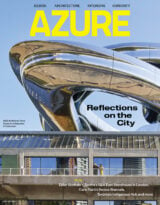For a Polish community with a postmodern interpretation of religion, Adamiczka Consulting has imagined an “un-church.”
Project
A Church for the Local Community
Location
Wrocław, Poland
Firm
Adamiczka Consulting, Wrocław, Poland
Team
Bartosz Adamiczka, Jerzy Adamiczka and Tomasz Broma
For a devout community in Poland, spirituality is as much about connecting with nature and community as with God. The Wrocław-based architecture firm Adamiczka Consulting approached this postmodern interpretation of religion with a postmodern house of worship, simple in form and modest in construction – the un-church, if you will.
Engaging with the building, formed of concentric rammed-earth quads, is akin to taking a journey through a labyrinth. Neighbours pass through slots in the two-storey outer walls to access a “procession path,” beyond which is another, deeper rammed-earth ring. In this second ring are carved small rooms with social functions: confessionals, community workplace, kitchen and refectory. In each, skylights bring in shafts of illumination.
“With this very serene project, there is the opportunity for the community to help, so it becomes a form of giving back, and also of receiving. That’s the great spirit in which this church is conceived.” – Nina-Marie Lister
Advancing further brings visitors to a sacred courtyard garden that opens to the sky. Plants here are intended to germinate without human interference, from seeds brought in by birds and wind. Changing with the seasons, the garden functions as an allegory for Creation.
This natural life cycle becomes especially poignant when one crosses the final ring of rammed earth, which is divided into 15 sections etched with the Stations of the Cross. Past the threshold is a nave entirely without adornment, with rows of pews lined up before the apse. Yet in place of the usual altarpiece, the designers have installed a back wall of full-height glazing with a view out to the sacred garden. This gesture, the designers explain, “is to support prayer by the contemplation of nature, its constant change, and to stand for God’s presence in the eternal cycle of life.” The experience would be nothing short of awe-inspiring.
The earthen walls, built from dirt dug up from a nearby residential development, are meant to reinforce the connection between God and community, and to remind everyone of the humble nature of the space. The effect? Luxurious.



